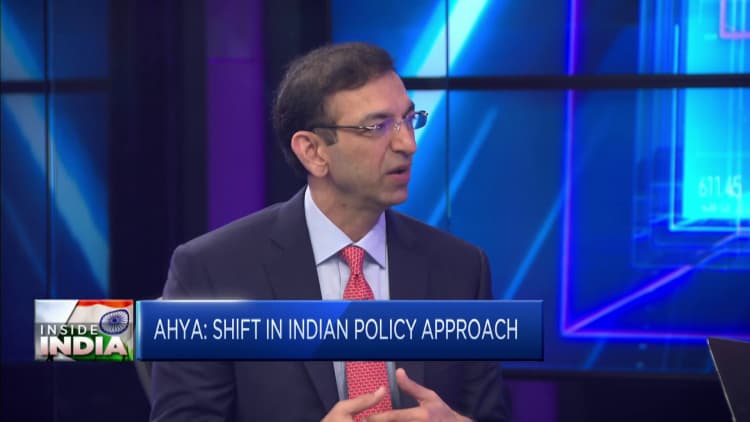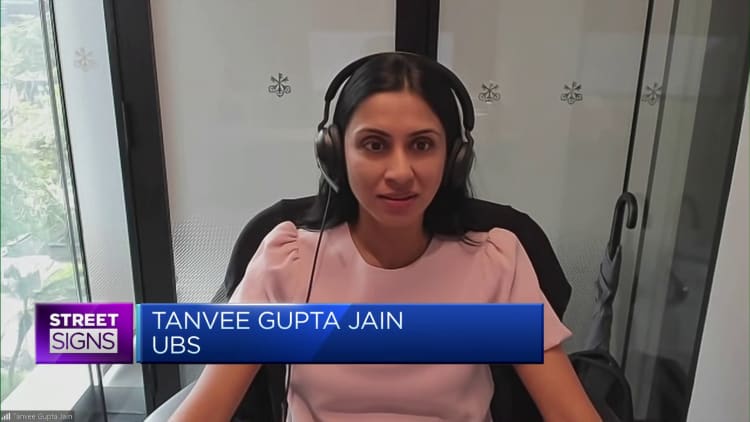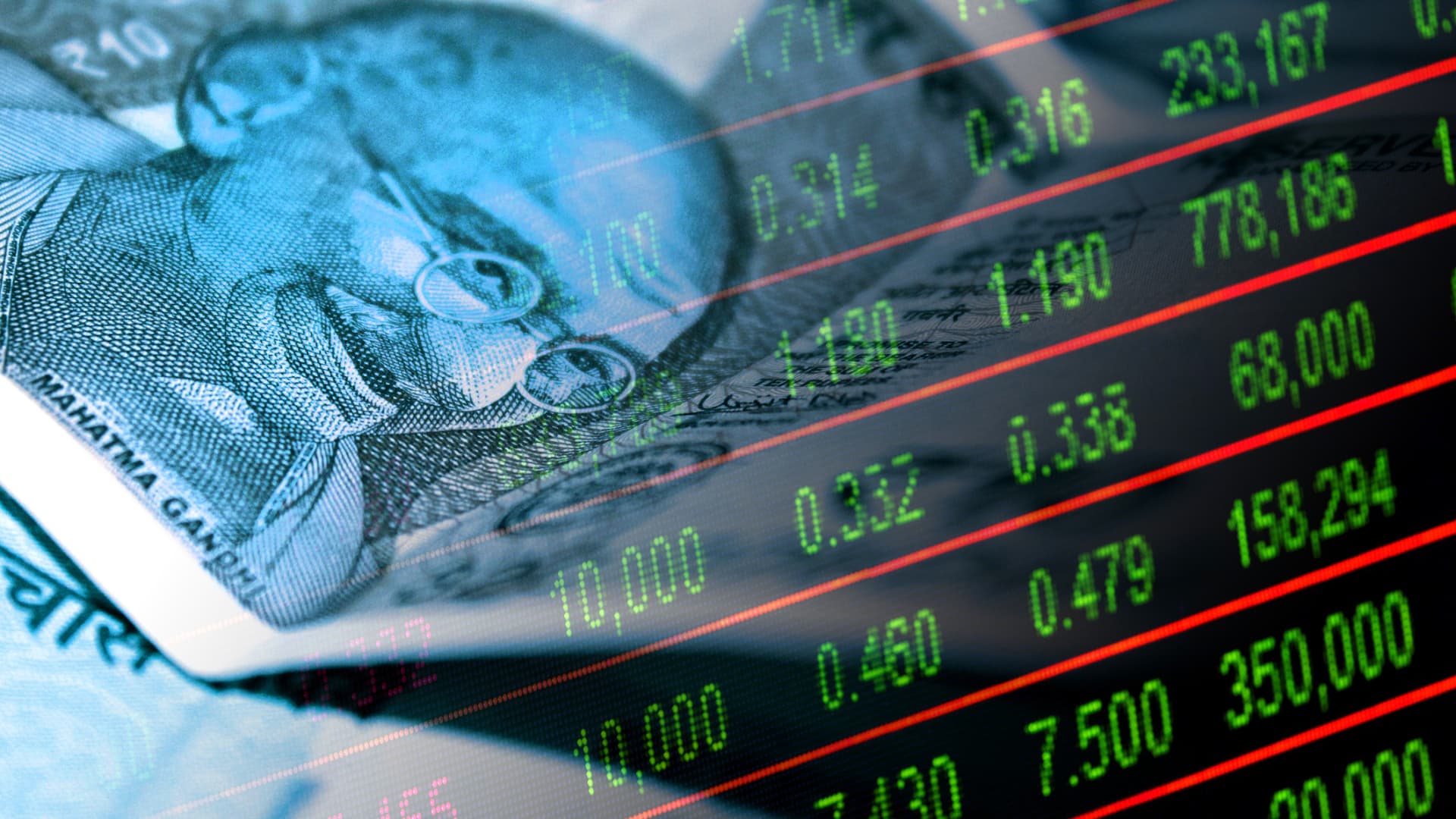An undated editorial illustration of Indian rupee cash bills and a stock market indicator board.
Javier Ghersi | Moment | Getty Images
When India abruptly announced import restrictions on personal computers and laptops in early August, it caught major suppliers such as Apple, Samsung and Dell by surprise.
By curtailing imports from major hardware manufacturers, the move was ostensibly aligned with Prime Minister Narendra Modi’s commitment to boost manufacturing under his “Make in India” program and position India as a high-tech manufacturing hub for everything from consumer electronics to semiconductors.
Yet, these shades of protectionism seem at odds with India’s eagerness to burnish its global reputation as the country prepares to host leaders from the Group of 20 leading industrialized and developing economies this weekend.
At a time when shifting geopolitical alliances are elevating India’s strategic importance, such curbs add to the contradictions global investors have to negotiate as they hunt for viable alternatives to a slowing China.
There’s also been this creeping increase in protectionism — some of it have been random. You don’t understand why they’ve done it…
Pravin Krishna
Johns Hopkins University’s School of Advanced International Studies
“I don’t want to call it a mystery of the system, but it’s certainly a slightly paradoxical aspect,” said Pravin Krishna, a professor in international economics at Johns Hopkins University’s School of Advanced International Studies.
“On the one hand, the government has shown keen interest in international investment, and manufacturing being set up in India on the one hand, and to provide a set of incentives for these players to come in,” he added.
“There’s also been this creeping increase in protectionism — some of it have been random. You don’t understand why they’ve done it and these are not necessarily powerful industries,” Krishna said.

The new regulations — released on Aug. 3 — restrict the imports of laptops, tablets, “all-in-one” personal computers and “ultra small form” factor computers and servers. They were initially effective immediately, but later delayed to November.
There are some exemptions, including single purchases from online vendors.
Responding on X, the social media platform formerly known as Twitter, India’s information technology minister, Rajeev Chandrasekhar, said the regulations were aimed at ensuring that India’s technology ecosystem uses only “trusted and verified” systems that are imported and domestically manufactured, while reducing dependence on imports.
“While the move will certainly boost the position of established domestic players — alongside global players with operations set up in the country, such as Apple — we are of the view that the introduction of restrictions will weigh on foreign [information and communications technology] vendors from a demand-side perspective,” Fitch’s BMI Industry Research analysts wrote in a note Aug. 8.
They said the move will add to end-product costs for foreign vendors and shift consumer spending toward Indian firms or established foreign vendors with a manufacturing base in India.
The top three mobile brands in India — China’s Xiaomi and Vivo, along with South Korea’s Samsung — have established manufacturing bases in the country, suggesting any new entrant will need to partner with an experienced domestic player with a manufacturing base or opt for greenfield investment in the market, said the BMI report.
To attract foreign investors, Modi’s government doubled to 170 billion rupees ($2.04 billion) its initial budget in May for a production-linked incentive scheme for IT hardware that was approved in 2021.
“As I see it, the government of India could have encouraged local production of laptops under [production-linked incentives] without restricting imports additionally in this manner,” Krishna said.
India vs. China
In the long term, India is the only single market that offers a potential scale comparable to that of China.
Sumedha Dasgupta
Economist Intelligence Unit
“Geopolitical strains between the US and China, the rapid adoption of e-commerce, the Covid-19 pandemic and the Russia-Ukraine war have led to a rethinking of strategies for reshoring sourcing, the diversification of supply routes and the localization of manufacturing,” Sumedha Dasgupta, a senior analyst with the Economist Intelligence Unit, told CNBC.
“Southeast Asian economies such as Vietnam have so far been the principal beneficiaries of supply chain diversification. However, India is increasingly well placed to capitalize on these trends, as, in the long term, India is the only single market that offers a potential scale comparable to that of China,” she added.
To be sure, Modi’s government has done plenty to bolster India’s economy in the decade that his ruling Bharatiya Janata Party party has been in power — from liberalizing foreign direct investment policies and investing heavily to improve infrastructure, to its push toward digitalization.

“India’s large and growing domestic market, limited political instability and long-term policy continuity bolsters India’s appeal to investors,” Dasgupta said. “India’s youthful demographic profile promises good availability of labor, which, in conjunction with less onerous labor regulation, will help to keep a lid on manufacturing labor costs, in contrast to China.”
The Modi administration’s prudent management through the Covid-19 pandemic has also helped India avoid the inflation issues that currently plague most of the industrialized world.
Escalating food prices though may end up curtailing growth this year. India has slapped export taxes on onions and banned the exports of rice, even as tomato prices surged more than 300% due to adverse weather.
Limits on investment
Despite other risks such as its declining labor force participation, Goldman Sachs expects India to become the world’s second-largest economy by 2075 — behind China and ahead of the U.S.
The International Monetary Fund predicted that India will be the fastest growing major economy this year.
Attracted by such lofty projections, global investors have also poured into Indian equity markets this year.
The benchmark Nifty 50 index has been one of the outperformers this year — rising more than 8% year-to-date, compared to a slide of nearly 2% for China’s CSI300 index — as global investors look to rotate out of China as its faltering post-Covid recovery has spooked investors about its longer term prognosis.
As a result, foreign institutional investors have bought poured about $17 billion into Indian equities this year so far, according to Goldman Sachs.
However, the same cannot be said of India’s bond markets. Capital controls could limit corporate India’s fund raising capacity in time to come.

India has been excluded from a major bond index over concerns over the potential inadequacy of domestic bond settlement systems and a perception that investor registration requirements, and India’s capital gains tax regime were not aligned to international standards, S&P Global analysts said.
“Easing rules for Indian companies to raise debt and equity externally and wider sovereign use of major international markets would broaden India’s funding sources,” they said in a note dated Aug. 3.
“The speed at which India’s capital markets catch up with the country’s ambitious development plans will in part depend on the government’s balancing act between capital controls and financial stability.”

